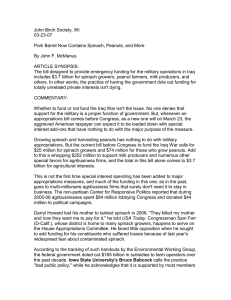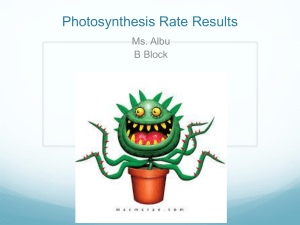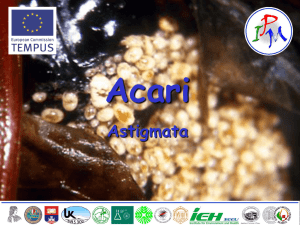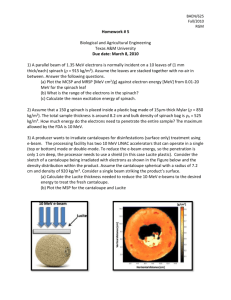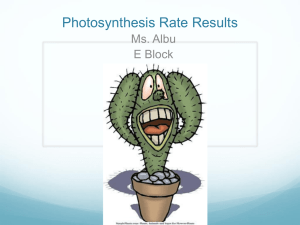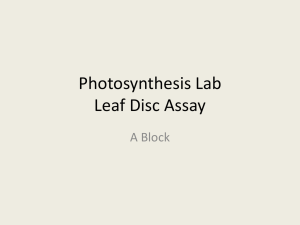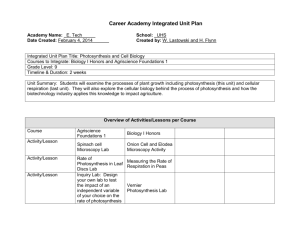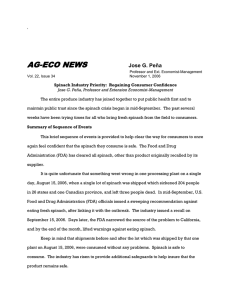File
advertisement
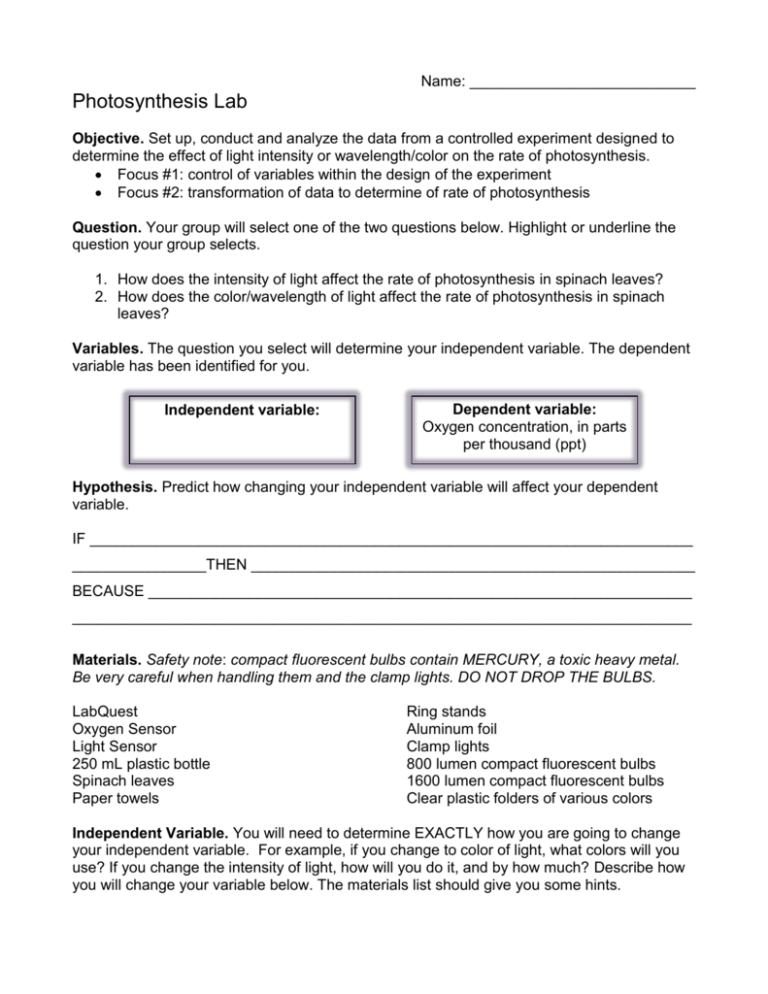
Name: ___________________________ Photosynthesis Lab Objective. Set up, conduct and analyze the data from a controlled experiment designed to determine the effect of light intensity or wavelength/color on the rate of photosynthesis. Focus #1: control of variables within the design of the experiment Focus #2: transformation of data to determine of rate of photosynthesis Question. Your group will select one of the two questions below. Highlight or underline the question your group selects. 1. How does the intensity of light affect the rate of photosynthesis in spinach leaves? 2. How does the color/wavelength of light affect the rate of photosynthesis in spinach leaves? Variables. The question you select will determine your independent variable. The dependent variable has been identified for you. Independent variable: Dependent variable: Oxygen concentration, in parts per thousand (ppt) Hypothesis. Predict how changing your independent variable will affect your dependent variable. IF ________________________________________________________________________ ________________THEN _____________________________________________________ BECAUSE _________________________________________________________________ __________________________________________________________________________ Materials. Safety note: compact fluorescent bulbs contain MERCURY, a toxic heavy metal. Be very careful when handling them and the clamp lights. DO NOT DROP THE BULBS. LabQuest Oxygen Sensor Light Sensor 250 mL plastic bottle Spinach leaves Paper towels Ring stands Aluminum foil Clamp lights 800 lumen compact fluorescent bulbs 1600 lumen compact fluorescent bulbs Clear plastic folders of various colors Independent Variable. You will need to determine EXACTLY how you are going to change your independent variable. For example, if you change to color of light, what colors will you use? If you change the intensity of light, how will you do it, and by how much? Describe how you will change your variable below. The materials list should give you some hints. __________________________________________________________________________ __________________________________________________________________________ __________________________________________________________________________ __________________________________________________________________________ Dependent Variable. You will be measuring the concentration of oxygen gas, using a LabQuest and an oxygen sensor. To maximize your chances of collecting good data, follow the guidelines below. 1. Use a lot of spinach. Use as many spinach leaves as you can get into the 250 mL plastic bottle without crushing or breaking the leaves. 2. If the leaves are wet, gently pat them dry with paper towels. Again, don’t crush or break. A little water is better than a crushed leaf. 3. Before beginning data collection, cover the plastic bottle (with the leaves inside and the sensor attached) with aluminum foil so that NO light enters. Leave covered for five minutes. Oxygen levels should drop as the leaves respire. 4. After removing foil, turn on lamps and expose leaves to light. Wait 10 minutes or until you see the oxygen begin to increase before starting data collection. 5. Set up the LabQuest to collect data at intervals of at least 30-60 seconds. Experiment with length of a trial. If the data collection period is too short, you won’t get enough data points. If it is too long, the lights might overheat the leaves. If you can’t remember how to set up the interval and length on a LabQuest, let Ziady know. I will help you. 6. If you are consistently observing an increase in oxygen followed by a leveling off, you are probably overheating the leaves. Place a beaker full of water between the lamp and the plastic bottle to act as a heat sink. 7. When you collect data, copy the data table created by the LabQuest into your notebook. If you don’t, all of your hard work will be lost!! Controlled Variables. The ONLY thing you want to change in your experiment is the independent variable. All other variables must remain constant for each trial, and between your control and experimental group. In the left column of the chart below IDENTIFY the things that you will need to keep constant. After you have experimented with the data collection, and are satisfied with your design, fill in the value for each controlled variable in the right column Controlled Variable Ex: Light Bulb Value of Controlled Variable Ex: 800 Lumens Practice, Test, Tinker. In an experiment, the control group is used to determine how the experimental subject (in this case, spinach leaves) behaves BEFORE you start changing the independent variable. In this case, how spinach leaves photosynthesize. The data from the control group gives you something to compare to your experimental group data, to see if the change in the independent variable had any effect. Your goal by the end of the first class session is to have a control group that produces a measureable change in oxygen concentration. To make this happen, you and your team are going to need to do a bit of practice and “experimentation.” Doing this will also help you determine the value of your controlled variables. Here are some things to think about: 1. How much spinach will I use? How will I measure the amount of spinach? 2. How many lights will I use? What strength of light? Where will the light be placed? 3. Am I following the suggestions described in the “Dependent Variable” section? If you are comfortable with the set up of your control group and have established the values of your controlled variables, you can move on to setting up your experimental group. Refer back to the “Independent Variable” section of this handout. However, you might have to make adjustments. Again: practice, mess around, try stuff out until you are comfortable with the set up of your experimental group. Experimental Design Description. In any experiment, there is going to be some down time, as you wait for data. When scientists conduct experiments and report their results, they need to describe the materials and methods they used. This allows other scientists to attempt to replicate and verify their results. This is something you will be doing as well, when you produce a lab report for either the Photosynthesis Lab or the Cell Respiration Lab. While you are waiting for data, you can work on a draft of a description of your Experimental Design below. __________________________________________________________________________ __________________________________________________________________________ __________________________________________________________________________ __________________________________________________________________________ __________________________________________________________________________ __________________________________________________________________________ __________________________________________________________________________ __________________________________________________________________________ __________________________________________________________________________ __________________________________________________________________________ __________________________________________________________________________ __________________________________________________________________________ __________________________________________________________________________ __________________________________________________________________________ __________________________________________________________________________ __________________________________________________________________________ __________________________________________________________________________ __________________________________________________________________________ __________________________________________________________________________ __________________________________________________________________________ __________________________________________________________________________ __________________________________________________________________________ __________________________________________________________________________ __________________________________________________________________________ __________________________________________________________________________ __________________________________________________________________________ __________________________________________________________________________ __________________________________________________________________________ __________________________________________________________________________ __________________________________________________________________________ __________________________________________________________________________ __________________________________________________________________________ __________________________________________________________________________ __________________________________________________________________________ __________________________________________________________________________ __________________________________________________________________________ __________________________________________________________________________ __________________________________________________________________________ __________________________________________________________________________ __________________________________________________________________________ __________________________________________________________________________ __________________________________________________________________________ __________________________________________________________________________ __________________________________________________________________________ __________________________________________________________________________ __________________________________________________________________________ __________________________________________________________________________ __________________________________________________________________________
